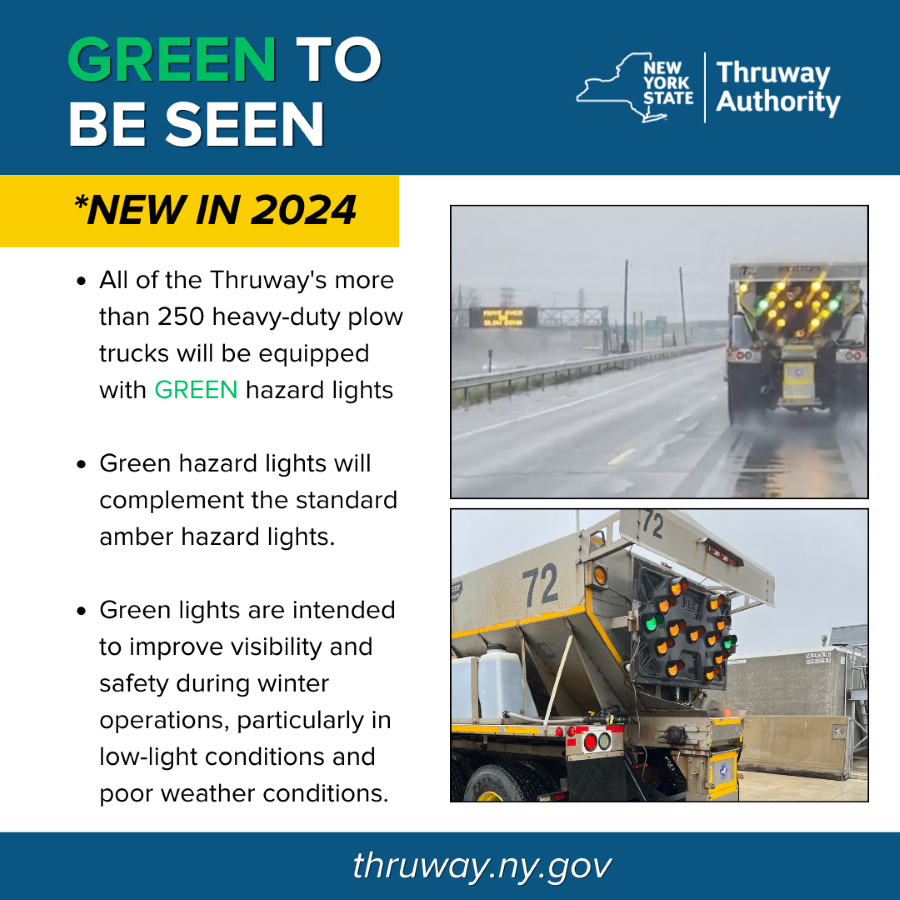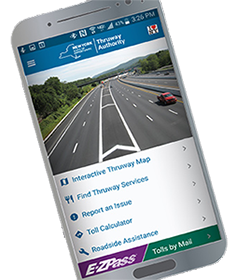Winter Maintenance
Equipment | Technology | iCone Pilot Program | Materials | Resources | Traveler Resources
Snow and ice control is one of the most demanding activities performed by New York State Thruway Authority staff, and our goal is to maintain safe driving conditions throughout winter storms along all parts of the 570-mile Thruway system. In order to respond as quickly as possible to winter weather, all Thruway maintenance locations are staffed 24/7 during the winter months. During the 2023 - 2024 snow and ice season, Thruway Authority operators cleared more than 1.1 million lane miles, removing roughly 172 inches, or more than 14 feet, of snow.
The Authority's four Divisions, New York, Albany, Syracuse and Buffalo, are tasked with the operational response to winter weather events. Within each division are the Authority’s 21 maintenance sections which are responsible for snow and ice operations covering approximately 30 centerline miles of roadway, as well as the accompanying interchanges, service areas and related facilities.

Equipment


The Thruway Authority’s snow and ice fleet consists of 260 large plow trucks, 11 tow plows and 142 smaller plows to remove snow and ice and apply salt and other anti-icing agents. A number of reserve plow trucks are incorporated in the overall total of 260 large plow trucks.
New for the 2024-2025 snow and ice season, all the Thruway's more than 250 heavy-duty plow trucks will be equipped with green hazard lights, complementing the standard amber hazard lights. Green lights are intended to improve visibility and safety during winter operations, particularly in low-light conditions and poor weather. Green lights on plow trucks were first approved in 2022 by amending the Vehicle and Traffic Law (VTL) paragraph 5 of subdivision 41 of VTL section 375. The lights will only be used for snow and ice removal.
In addition to the plow trucks, each location also has other ancillary equipment such as front-end loaders and snow blowers. These units are stationed strategically across the system and relocated as forecasts and conditions dictate.
Snow plows travel at about 35 miles per hour — which in many cases is slower than the posted speed limit — in order to ensure that salt being dispersed stays in the driving lanes and does not scatter off the roadways. The safest place for motorists is well behind the snow plows where the roadway is clear and salted.


Technology


Each large plow truck in the Thruway Authority's fleet is equipped with an enhanced Global Positioning Device (GPS) which allows for real-time monitoring during plowing operations, including route tracking, air and pavement temperature and deicing material application rates for each truck engaged in storm response. The system also reports pavement and air temperature conditions via on-board sensors, provides advanced reporting that highlights when each roadway section is serviced, and illustrates when plow trucks are actively engaged in snow removing operations.
The Thruway Authority also has 12 snow measurement weather stations in our Syracuse and Buffalo Divisions that allow for real-time, localized weather and snowfall rate monitoring. The system collects measurements such as temperature, relative humidity, wind speed and direction, surface pressure, soil moisture, soil temperature, solar radiation, and precipitation amounts for rainfall and snow accumulation.
The use of Closed Circuit Television (CCTV) cameras at interchanges and other key locations also provide real-time operational assessments.
iCone Pilot Program
As part of the Thruway Authority’s ongoing commitment to enhancing safety for both plow operators and the traveling public, the Authority is launching a pilot program in partnership with iCone. This initiative will involve equipping 50 heavy-duty plow trucks with devices that can provide real-time data to popular vehicle navigation applications such as Google Maps and Waze. During snow operations, the device connects with navigation systems to alert drivers about potential upcoming hazards, such as snowplow activities. This alerts motorists to be aware and to navigate the area safely, significantly enhancing driving efficiency and ensuring the safety of plow operators.
The devices will be installed and operational in select plows in each of the Thruway’s four Maintenance Divisions where the highest number of plow crashes took place in the last five years. If successful, the Authority will look to installing iCone devices in all Thruway plow trucks.
During Winter 2023-2024, there were 16 crashes involving Thruway plows while engaged in snow operations. In the last five years, Thruway plows have been involved in more than 75 crashes.
Materials
The Thruway Authority's primary method to fight roadway icing is rock salt. The average annual usage for the past 10 years is 176,544 tons. The Authority’s 42 storage locations provide for the secure covered storage of 136,630 tons of salt. Sheds are filled prior to the start of winter and salt is reordered as usage occurs throughout the season. In addition to rock salt, the Authority utilizes salt brine and a magnesium chloride-brine mixture in both an anti-icing application and as a pre-treatment for the rock salt. Magnesium chloride is utilized to improve effectiveness at lower temperatures.


Resources
The Thruway Authority monitors and responds to weather conditions in collaboration with multiple state and local agencies.
The Thruway Statewide Operations Center (TSOC), housed at the Authority's Administrative Headquarters in Albany, is the central location for the coordination of all traffic incident response, emergency management, and dissemination of traveler information along the entire Thruway. TSOC operates 24 hours a day, 7 days a week, 365 days a year. The Authority exchanges traffic and Intelligent Transportation Systems (ITS) data with the New York State Department of Transportation through the Regional Traffic Operation Centers, providing the public with a view of traffic operations across New York State so they may make more informed travel choices.


Information is provided to TSOC through a range of systems including:
- 194 closed circuit television cameras, many of which can be viewed on the Thruway's website
- 72 closed circuit television cameras at Service Areas
- 110 permanent Variable Message Signs (VMS)
- 125 portable Variable Message Signs (PVMS)
- 124 real‐time vehicle detector sites (TRANSMIT)
In preparation of a specific event, the Thruway Authority coordinates with state and local agencies.
- NYS Division of Homeland Security and Emergency Services
- NYSDOT Regional and Main Office
- State Police
- County Emergency Managers
- Local Police agencies
- Local Emergency response
- National Weather Service
Thruway Authority Division Operation Centers (DOCs) and the Headquarters Operation Center (HQOC) are activated during a significant storm upon direction of the Director of Maintenance and Operations. The DOC is in contact with the Maintenance and Traffic supervisors during winter weather, who are traveling the roadways monitoring conditions and adjusting resources if needed. Staff at the DOC also monitor information from roadway cameras, State Police patrols and updated weather forecasting to adjust resources to meet service levels and impacts of incidents on the roadway.
Traveler Resources
Thruway travelers can monitor weather conditions 24/7 year round through various resources.
- New York State Thruway Mobile app connects motorists to real-time information about the Thruway system. Travelers can access the latest road conditions, calculate tolls, report issues or road conditions, among other services. The app is free to download on iPhone
 and Android
and Android  devices.
devices. - Interactive map on the New York State Thruway's website includes traffic incidents, road closures, construction and color coded winter travel advisories. Motorists can also view traffic cameras located across the Thruway system.
- TRANSalerts, an email service to customers that provides real-time information about incidents that may affect travel on the Thruway. Motorists can sign up for email and text messages alerts at: https://transalerts.thruway.ny.gov/.
